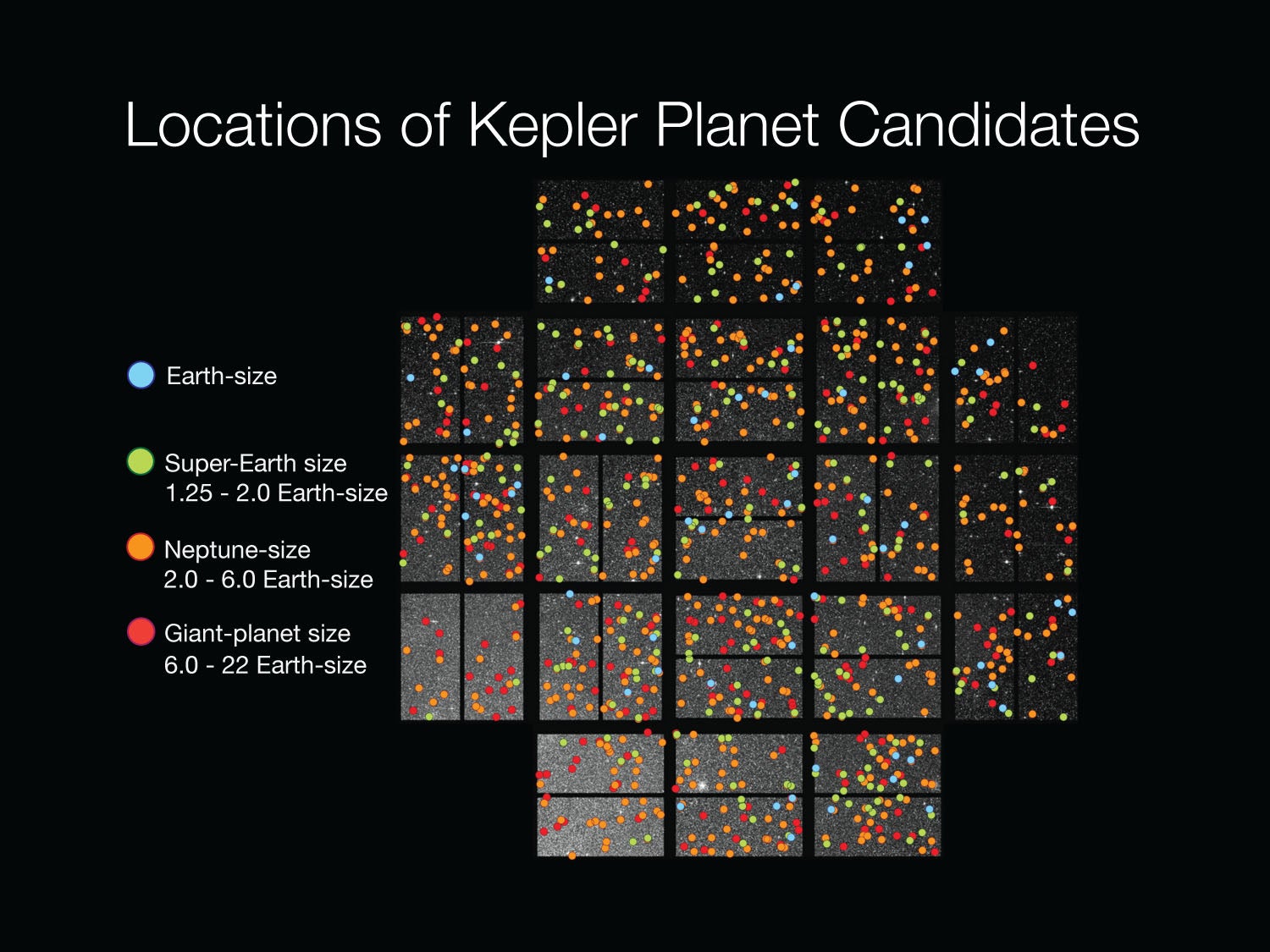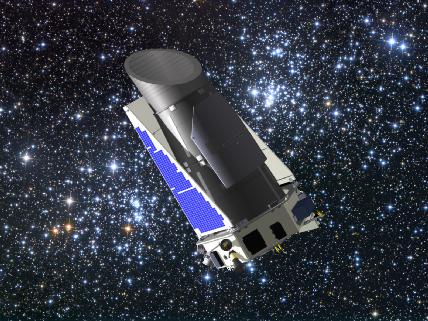Are any of the potentially 25 billion Earth-like planets in our galaxy like Earth?
ListenEarth-like is a very relative term; mass, size, distance from star, atmosphere, temperature, orbiting period are all factors that make our Earth uniquely suitable to life as we know it. Of the 973 confirmed exoplanets identified by Kepler survey, 177 are in the habitable zone around their parent star. Comet ISON – brightening slower than expected. Visible in binoculars in the pre-dawn sky near Regulus in constellation LEO. Find it here. Leonid Meteor Shower – Saturday night/Sunday morning and again Sunday night but weak with bright moonlight to hamper viewing. Mark your calendar for the next US Total Solar Eclipses – August 21, 2017 and April 8, 2024
November 11, 2013
[Dave Heller] Interest in astronomy surged last week with the news that Kepler survey analysis revealed the potential for the existence of billions of Earth-like planets. Let’s take a closer look at that count with Derrick Pitts, chief astronomer at the Franklin Institute. Derrick, I’m concerned that you’re going to try to curb our enthusiasm.
[Derrick Pitts] (Laughs) No, I’m actually going to refocus the enthusiasm rather than curb the enthusiasm. And the reason why is the science behind the story last week of 25 billion Earth-like planets, or 22% of the planets that are possibly found in our galaxy could be Earth-like, you know that’s all great stuff. But we really have to shape that in just the right way so that people understand what’s really going on with this.
I guess for starters we have to come to a common consensus on what “Earth-like” planet means.
Well, that’s really very important. Because if you’re talking about Earth-like relative to all of the other kinds of planet objects that have been found, well we really do have to narrow the focus tremendously because “Earth-like” could mean a lot of things. Are we talking about the size of an object? Are we talking about the mass of an object, distance from its star, its temperature, its atmosphere, its orbital period — which of those things are we talking about that describes “Earth-like”? So the way we have to shape that to begin with is we have to describe “Earth-like” as really being an object that’s about the size or the mass of this planet, our planet. And it has to be an object that is rocky, that has an atmosphere — at least an atmosphere — and it has to be at the correct distance from its parent star with an orbital period that makes sense so that the temperature of that object is close to Earth temperature. We’re talking about somewhere, you know, an average temperature of say 65 degrees Fahrenheit, or 70 degrees Fahrenheit.
-
NASA’s Kepler space telescope, now crippled and its four-year mission at an end, nevertheless provided enough data to complete its mission objective: to determine how many of the 200 billion stars in our galaxy have potentially habitable planets. Based on a statistical analysis of all the Kepler observations, UC Berkeley and University of Hawaii, Manoa, astronomers now estimate that one in five stars like the sun have planets about the size of Earth and a surface temperature conducive to life. Credit: Petigura/UC Berkeley, Howard/IfA, Marcy/UC Berkeley, Illumina Studios.
So each and all of those variables must be accounted for?
They have to be, because there are objects that are two or three times the size of our Earth that are being described as “Super-Earths” … well, that’s just three times the size of Earth. Do they really require being called “Super”? Super in the sense that they’re bigger, but every other aspect of them is not like Earth. So we can find objects that are the size of our planet, but they’re three million miles away from their sun. So their surface temperature is 3000 degrees. That completely precludes the possibility of an Earth-like atmosphere. So that’s not Earth-like.
Now what this study has done is, it’s looked at the survey data from Kepler and it has extrapolated that out in a very sensible way. And it has also very carefully tried to account for all sorts of other variations about the physical relationship between those possible stars and their possible planets that might screw up the number in some way. So it’s been very careful to clearly define the parameters of the study. That study then suggests that the number of stars that have planets could result in the possibility — again, suggest that the number of Earth-like planets be somewhere around 22% of those, or something like 25 – 40 billion planets.
-

This graphical representation of Kepler planet candidates is organized by location and size. Image Credit: NASA
The Kepler work though is done. How do we take this and launch it into the next era?
If we looked at Kepler’s work, Kepler did a very narrow, very small section of our galaxy. We simply extended that survey with statistics to allow us to get an idea, a constant sense, a model of how the rest of the galaxy may have planets or not. Now what we have to do is we have to extend that survey, get some real, hard data on the actual number of real Earth-like planets and then use that as a way to model what the real number of Earth-like planets are. And then we need to directly identify something that really is Earth-like.
“If we looked at Kepler’s work, Kepler did a very narrow, very small section of our galaxy. We simply extended that survey with statistics to allow us to get an idea … of how the rest of the galaxy may have planets or not.”
Derrick Pitts
-

Kepler. Photo credit: NASA
Gosh, if we ever did discover sentient life on another planet, we still haven’t solved the riddle of how to communicate with them faster than the speed of light.
And that’s a really important point because the survey goes on to say that the way in which the stars that could have Earth-like planets are distributed through the galaxy such that suggests, again, that there’s a star within 12 light years of Earth. But we still have to overcome that enormous gulf of 12 light years. This is an object travelling at the speed of light, 300,000 kilometers per second, for 12 years. Currently our spacecraft are nowhere near that speed in their transit through our solar system. So that really means either a trip of communications of 24 years round trip — 12 years out, 12 years back — but if we’re actually talking about a physical trip, hundreds of thousands of years to cover those distances.
Let’s come back and go with what we know. What’s available to be seen in the night-sky this week, both natural and manmade?
Well there’s actually plenty of really interesting stuff we can see in the evening sky. First of all, there’s the Leonid meteor shower that comes up Saturday night / Sunday night. The Leonid meteor shower is a well-known shower because every 33 years or so there’s a great shower of meteors connected to its parent comet, Comet Swift-Tuttle. Now Swift-Tuttle last made its closest approach in our solar system in 1998, so that means from now on, for the next 20-25 years or so, you’re not going to see such a big shower. But, if you happen to be out, perhaps you can see some but the likely-hood is low because there’s a bright moon. But at the same time, over on the evening side of the sky, just after sunset we can see the beautiful planet Venus hanging up there without too much difficulty, within 40 minutes after sunset. And then around on the pre-dawn sky we can find bright Jupiter; Jupiter’s not rising long before midnight, and so it’s high in the southwestern sky at sunrise. Comet Ison is also on that side of the pre-dawn sky, about 2 hours, 3 hours before sunrise. But it’s still very faint and it will not become to naked eye a brilliance until after Thanksgiving.
“The Leonid meteor shower is a well-known shower because every 33 years or so there’s a great shower of meteors connected to its parent comet, Comet Swift-Tuttle. Now Swift-Tuttle last made its closest approach in our solar system in 1998, so that means from now on, for the next 20-25 years or so, you’re not going to see such a big shower.”
Derrick Pitts
-
Leonid Meteor Shower, 2009
You know we talked last week about the potential to peer at a partial solar eclipse. When’s the next full eclipse?
You know the full monty for the sun is coming up again in the U.S. in August of 2017. August 21, to be precise. And at that time, the path of totality across the U.S. for the east coast brings that path right through South Carolina. On either side of that very narrow path, sixty to seventy miles wide, you’ll see just a partial eclipse. But this is a great, great time for us to do a nice car trip down to the location where we can see it and see a truly spectacular astronomical event.
I’ll see it on I-95 South on the way down.
Let’s do it!
WHYY is your source for fact-based, in-depth journalism and information. As a nonprofit organization, we rely on financial support from readers like you. Please give today.




